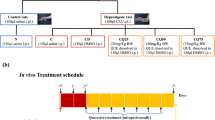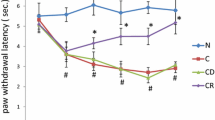Abstract
Reactive oxygen species are signaling mediators of nociceptive pathways. Exogenous administrations of antioxidants show anti-hyperalgesic effect. However, very little is known about the role of endogenous antioxidant defense system in pain pathology. Curcumin is a dietary antioxidant which shows ameliorative effect on thermal hypersensitivity, however detailed study is lacking. Present study was aimed to analyze the changes in oxidative stress, modulation of antioxidant enzymes and pro-inflammatory cytokines in complete Freund’s adjuvant induced inflammatory hyperalgesia and the effect of curcumin on antioxidant defense system and pro-inflammatory cytokines. Anti-hyperalgesic activity of curcumin was evidenced after 6 h of treatment. Oxidative stress was evidenced in paw skin and spinal cord of hyperalgesic rats by high level of lipid peroxidation. A decrease in activity of antioxidant enzymes like catalase, superoxide dismutase, glutathione peroxidase, glutathione reductase and an increase in level of pro-inflammatory cytokines TNF-α, IL-1β and IL-6 in paw skin was observed as compared to normal rats. However, activity of antioxidant enzymes was enhanced in spinal cord. The changes were brought towards normal level after curcumin treatment. The results suggest that modulation of antioxidant defense system is early event in initiation of inflammatory hyperalgesia which might lead to initiation of other signaling pathways mediated by lipid peroxide, TNF-α, IL-1β and IL-6. Decrease in oxidative stress and down regulation of these cytokines by curcumin is suggested to be involved in its anti-hyperalgesic effect.







Similar content being viewed by others
References
Kim HK, Park SK, Zhou JL, Taglialatela G, Chung K, Coggeshall RE et al (2004) Reactive oxygen species (ROS) play an important role in a rat model of neuropathic pain. Pain 111:116–124
Lee KimHK, Kim JH, Chung K, Chung JM (2007) The role of reactive oxygen species in capsaicin-induced mechanical hyperalgesia and in the activities of dorsal horn neurons. Pain 133:9–17
Schwartz ES, Lee I, Chung K, Chung JM (2008) Oxidative stress in the spinal cord is an important contributor in capsaicin-induced mechanical secondary hyperalgesia in mice. Pain 138:514–524
Jenner P (1994) Oxidative damage in neurodegenerative disease. Lancet 344:796–798
Tal M (1996) A novel antioxidant alleviates heat hyperalgesia in rats with an experimental painful peripheral neuropathy. NeuroReport 7:1382–1384
Wang ZQ, Porreca F, Cuzzocrea S, Galen K, Lightfoot R, Masini E et al (2004) A newly identified role for superoxide in inflammatory pain. J Pharmacol Exp Ther 309:869–878
Kohli K, Ali J, Ansari MJ, Raheman Z (2005) Curcumin: a natural anti-inflammatory agent. Indian J Pharmacol 37:141–147
Yeon KY, Kim SA, Kim YH, Lee MK, Ahn DK, Kim HJ et al (2010) Curcumin produces an antihyperalgesic effect via antagonism of TRPV1. J Dent Res 89(2):170–174
Kunchandy E, Rao MNA (1990) Oxygen radical scavenging activity of curcumin. Int Pharm 58:237–240
Sharma S, Kulkarni SK, Agrewala JN, Chopra K (2006) Curcumin attenuates thermal hyperalgesia in a diabetic mouse model of neuropathic pain. Eur J Pharmacol 536:256–261
Khattab MM (2006) TEMPOL, a membrane permeable radical scavenger, attenuates peroxynitrite and superoxide anion enhanced carrageenan induced paw edema and hyperalgesia: a key role for superoxide anion. Eur J Pharmacol 548:167–173
Salvemini D, Wang ZQ, Zweier JL, Samouilov A, Macarthur H, Misko TP et al (1999) A nonpeptidyl mimic of superoxide dismutase with therapeutic activity in rats. Science 286:304–306
Keeble JE, Bodkin JV, Liang L (2009) Hydrogen peroxide is a novel mediator of inflammatory hyperalgesia, acting via transient receptor potential vanilloid 1-dependent and independent mechanisms. Pain 141:135–142
Mittal N, Joshi R, Hota D, Chakrabarti A (2009) Evaluation of antihyperalgesic effect of curcumin on formalin-induced orofacial pain in rat. Phytother Res 23:507–512
Ohkawa H, Ohishi N, Yagi K (1979) Assay for lipid peroxides in animal tissues by thiobarbituric acid reaction. Anal Biochem 95:351–358
Sharma R, Vinayak M (2011) α-Tocopherol attenuates NF-κB activation and pro-inflammatory cytokine secretion in cancer-bearing mice. Biosci Rep 31:421–428
Aebi H (1974) catalase. In: Bergmeyer HU (ed) Methods in enzymatic analysis, 2nd edn. Academic Press, New York, pp 673–678
Winterbourne CC, Hawkins RE, Brian M, Carrell RW (1975) The estimation of red cell superoxide dismutase activity. J Lab Clin Med 85:337–341
Pagalia DE, Valentine WN (1967) Studies on the quantitative and qualitative characterization of erythrocyte glutathione peroxidase. J Lab Clin Med 70:158–169
Ho YS, Magnenat JL, Bronson RT, Cao J, Gargano M, Sugawara M et al (1997) Mice deficient in cellular glutathione peroxidase develop normally and show no increased sensitivity to hyperoxia. J Biol Chem 272(26):16644–16651
Horn HD (1965) Glutathione reductase. In: Bergmeyer H (ed) Methods of enzyme analysis. Academic Press, New York, pp 875–879
Ren K, Dubner R (1999) Inflammatory models of pain and hyperalgesia. ILAR J 40(3):111–118
Billiau A, Matthys P (2001) Modes of action of Freund’s adjuvants in experimental models of autoimmune diseases. J Leukoc Biol 70:849–860
Salvemini D, Little JW, Doyle T, Neumann WL (2011) Roles of reactive oxygen and nitrogen species in pain. Free Radic Biol Med 51(951–966):4
Bowie A, O’Neill LA (2000) Oxidative stress and nuclear factor-kappaB activation: a reassessment of the evidence in the light of recent discoveries. Biochem Pharmacol 59(1):13–23
Julius D, Basbaum AI (2001) Molecular mechanisms of nociception. Nature 413:203–210
Varija D, Kumar KP, Reddy KP, Reddy VK (2008) Prolonged constriction of sciatic nerve affecting oxidative stressors and antioxidant enzymes in rat. Indian J Med Res 129(587–592):7
Guedes RP, Bosco LD, Teixeira CM, Araújo ASR, Llesuy S, Belló-Klein A et al (2006) Neuropathic pain modifies antioxidant activity in rat spinal cord. Neurochem Res 31:603–609
Stefanson AL, Bakovic M (2014) Dietary regulation of Keap1/Nrf2/ARE pathway: focus on plant-derived compounds and trace minerals. Nutrients 6:3777–3801
Balogun E, Hoque M, Gong P, Killeen E, Green CJ, Foresti R et al (2003) Curcumin activates the haemoxygenase-1 gene via regulation of Nrf2 and the antioxidant-responsive element. Biochem J 371:887–895
Singh S, Aggarwal BB (1995) Activation of transcription factor NF-kB is suppressed by curcumin (diferulolylmethane). J Biol Chem 270(20):24995–25000
Viggiano A, Monda M, Viggiano A, Viggiano D, Viggiano E, Chiefari M et al (2005) Trigeminal pain transmission requires reactive oxygen species production. Brain Res 1050:72–78
Chen Y, Boettger MK, Reif A, Schmitt A, Üçeyler N, Sommer C (2010) Nitric oxide synthase modulates CFA-induced thermal hyperalgesia through cytokine regulation in mice. Mol Pain 6:13
Matata BM, Galinanes M (2002) Peroxynitrite is an essential component of cytokine production mechanism in human monocytes through modulation of nuclear factor-kappa B DNA binding activity. J Biol Chem 277:2330–2335
Das L, Vinayak M (2014) Curcumin attenuates carcinogenesis by down regulating proinflammatory cytokine interleukin-1 (IL-1α and IL-1β) via modulation of AP-1 and NF-IL6 in lymphoma bearing mice. Int Immunopharmacol 20:141–147
Sancho P, Martín-Sanz P, Fabregat I (2011) Reciprocal regulation of NADPH oxidases and the cyclooxygenase-2 pathway. Free Radic Biol Med 51:1789–1798
Watkins LR, Milligan ED, Maier SF (2001) Glial activation: a driving force for pathological pain. Trends Neurosci 24:450–455
Rittner HL, Machelska H, Stein C (2005) Leuckocyte in the regulation of pain and analgesia. J Leukoc Biol 78:1215–1222
Hensellek S, Brell P, Schaible HG, Bräuer R, von Bancheta GS (2007) The cytokine TNFα increases the proportion of DRG neurons expressing the TRPV1 receptor via the TNFR1 receptor and ERK activation. Mol Cell Neurosci 36:381–391
Ji RR, Befort K, Brenner GJ, Woolf CJ (2002) ERK MAP kinase activation in superficial spinal cord neurons induces prodynorphin and NK-1 upregulation and contributes to persistent inflammatory pain hypersensitivity. J Neurosci 22(2):478–485
Puntambekar P, Mukharjea D, Jajoo S, Ramkumar V (2005) Essential role of Rac1/NADPH oxidase in nerve growth factor induction of TRPV1 expression. J Neurochem 95(6):1689–1703
Cunha FQ, Ferrreria SH (2003) Peripheral hyperalgesic cytokines. Adv Exp Med Biol 521:22–39
Colston JT, Chandrasekar B, Freeman GL (2002) A novel peroxide-induced calcium transient regulates interleukin-6 expression in cardiac-derived fibroblasts. J Biol Chem 277:23477–23483
Sredni-Kenigsbuch D, Kambayashi T, Strassmann G (2000) Neutrophils augment the release of TNF alpha from LPS-stimulated macrophages via hydrogen peroxide. Immunol Lett 71:97–102
Acknowledgments
Authors are thankful to DRDO, India for financial support (Grant No. ERIP/ER/1003851/M/01/1336). A.K.S. thanks UGC, India for JRF & SRF.
Conflict of interest
None.
Author information
Authors and Affiliations
Corresponding author
Rights and permissions
About this article
Cite this article
Singh, A.K., Vinayak, M. Curcumin Attenuates CFA Induced Thermal Hyperalgesia by Modulation of Antioxidant Enzymes and Down Regulation of TNF-α, IL-1β and IL-6. Neurochem Res 40, 463–472 (2015). https://doi.org/10.1007/s11064-014-1489-6
Received:
Revised:
Accepted:
Published:
Issue Date:
DOI: https://doi.org/10.1007/s11064-014-1489-6




